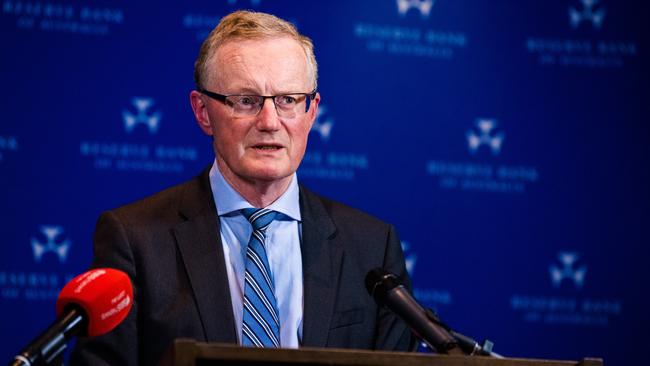Genie stays in the bottle as Reserve Bank governor Philip Lowe sticks to his forecast

With inflation barely visible compared to the RBA’s target range of 2-3 per cent, Lowe believes he needs an outbreak in annual wages growth of about 3 per cent to get there.
Over the last 40 years, it’s only happened once, and that was during a labour shortage in the resources boom.
The growth rate took a peek at life in a booming economy, didn’t like what it saw and promptly retreated to 1.5 per cent.
“I don’t think it’s particularly likely that it shoots back up to above 3 per cent over the next 18 months,” the governor said on Tuesday. “And until wage growth is back up above 3 per cent, I have trouble with the notion that inflation can be sustainably in the 2-3 per cent target range.”
Among the many adjustments we’ve all had to make in the pandemic era is that the scourge of inflation is now regarded by policymakers as a blessing.
The reason is that the global central bankers’ club has fired all its ammunition – and then some – in trying to refloat their respective economies.
While the world has only just started to see a pathway out of the crisis, the risk that inflation might become entrenched means that it’s already time to prepare for the next downturn.
In Lowe’s words, the cash rate is at a record low of 0.1 per cent, and it’s important for macroeconomic management that it “normalises” and trends higher.
The RBA has no formal target for wage growth.
However, it’s the transmission mechanism to achieve inflation in the target range by effectively creating the same kind of labour scarcity which briefly characterised the resources boom.
The real economy has performed wonderfully well in recovering from the early stage of the pandemic. Unemployment has fallen to 5.1 per cent compared to RBA expectations of 6.5 per cent only last February, but there are still no sustainable signs of economy-wide pay rises.
Lowe sees the solution as an even lower unemployment rate.
Again because of a lack of precedent, he’s unsure of what the threshold might be to create some elusive momentum.
But needless to say, the number has a 4 in front of it, and more likely to be in the low 4 per cent range instead of closer to 5 per cent.
There was a lot of commentary on Tuesday about the likelihood of the RBA bringing forward its forecast of an increase in the cash rate to 2023 – or possibly even next year – from 2024.
But Lowe just can’t see it happening from where we stand.
“So if you think we’re going to raise interest rates in 2023, you’ve got to have a much more positive forecast for wages growth than we currently have, which would require the dynamics in the labour market to be very different to those that have been at work over the past decade,” he said.
“Those dynamics have been pretty powerful – a big increase in labour supply, and the perception by businesses that they have trouble raising prices and therefore they want to keep control of their costs.
“So all those factors would have to change fundamentally to get wages growth above 3 per cent and the inflation rate much higher than it currently is.”
Back to earth
The pandemic-induced boom in markets revenue enjoyed by the major banks is drawing to a close, as a deep pool of liquidity drenches a year or so of extreme volatility.
Institutional businesses around the world are starting to feel the pain.
Last month, JPMorgan chief executive Jamie Dimon said trading revenue at the largest US bank would fall 38 per cent in the second quarter to a bit more than $US6bn.
This compared to an already reduced average analyst forecast of $US6.5bn.
Morgan Stanley boss James Gorman tempered expectations at the same conference, warning that the bank’s revenue would be nowhere near the “gangbusters” level seen in the first quarter.
Back in Australia, ANZ and Macquarie are seen as the most vulnerable to measures of volatility returning to pre-pandemic levels in the second half of 2019.
“Both benefited materially ahead of peers from trading revenues and commodity volatility, which if heading back to 2019 levels would present downside risk,” Citi analyst Brendan Sproules said.
“This added headwind, on top of a list of challenging dynamics in traditional lending and deposit-gathering, goes to the core of our preference for the retail banks over the business banks and Macquarie.”
Catching up last week with ANZ institutional boss Mark Whelan, Sproules said he came away with the “distinct feeling” that the revenue outlook was challenging.
Institutional banking results, he said, were being weighed down by deposit margins and falling demand for credit, as excess liquidity and deleveraging took a toll.
While Covid-related repricing of loans had helped somewhat, the benefit was again limited by surplus liquidity.
ANZ’s gangbusters markets result came in the September 2020 half-year, when revenue jumped to $1.5bn – 50 per cent higher than the $1bn level regarded by the bank as “normal”.
The big reversal to $1.04bn came in the following six-month period, with revenue still boosted by $164m from the rising value of high-quality liquid assets.
gluyasr@theaustralian.com.au
Twitter: @Gluyasr



Reserve Bank governor Philip Lowe has a fairly simple response to pundits who fear that the central bank’s dovish approach to monetary policy is going to unleash the inflation genie.